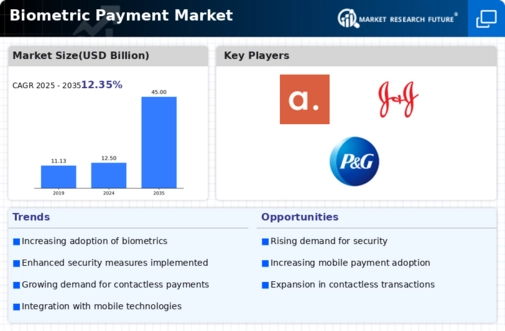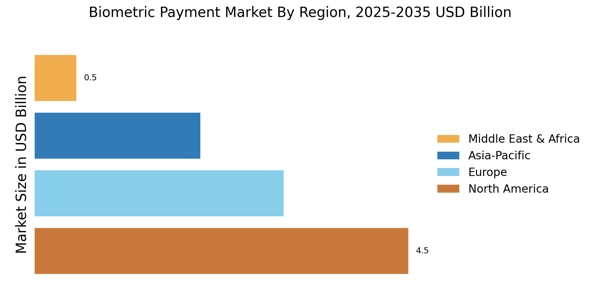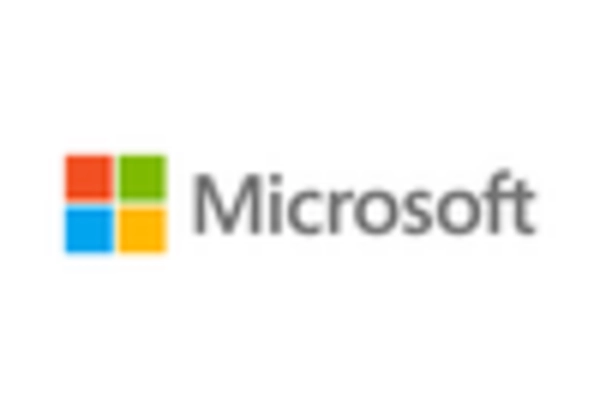Growing Concerns Over Fraud and Security
The Biometric Payment Market is increasingly influenced by growing concerns over fraud and security. As digital transactions become more prevalent, the risk of identity theft and fraudulent activities rises. Biometric payment solutions offer a robust defense against such threats by utilizing unique biological traits for authentication. This heightened security is particularly appealing to financial institutions and retailers, as it helps mitigate losses associated with fraud. Recent statistics indicate that biometric authentication can reduce fraud rates by up to 90%, making it a compelling choice for businesses seeking to protect their customers. Consequently, the demand for biometric payment systems is expected to rise as organizations prioritize security in their payment processes.
Rising Demand for Contactless Transactions
The Biometric Payment Market is experiencing a notable surge in demand for contactless transactions. As consumers increasingly prefer seamless and efficient payment methods, biometric solutions such as fingerprint and facial recognition are gaining traction. According to recent data, the contactless payment segment is projected to grow at a compound annual growth rate of over 20% in the coming years. This trend is driven by the convenience and speed offered by biometric payments, which eliminate the need for physical cards or cash. Furthermore, the integration of biometric technology into mobile wallets enhances user experience, making transactions quicker and more secure. As a result, businesses are investing in biometric payment systems to meet consumer expectations and remain competitive in the evolving payment landscape.
Increased Investment in Fintech Innovations
The Biometric Payment Market is witnessing a surge in investment in fintech innovations. Venture capital and private equity firms are increasingly funding startups that focus on biometric payment solutions, recognizing the potential for high returns in this rapidly evolving sector. Recent reports suggest that investment in fintech, particularly in biometric technologies, has reached unprecedented levels, with billions of dollars allocated to research and development. This influx of capital is driving innovation and enabling companies to develop cutting-edge biometric payment systems that cater to diverse consumer needs. As competition intensifies, the Biometric Payment Market is poised for significant growth, fueled by the continuous influx of investment and the emergence of new players in the market.
Regulatory Support for Biometric Technologies
Regulatory support is emerging as a significant driver for the Biometric Payment Market. Governments and regulatory bodies are increasingly recognizing the potential of biometric technologies to enhance security and streamline payment processes. Initiatives aimed at promoting digital identity verification and secure payment methods are gaining momentum. For example, certain jurisdictions are implementing regulations that encourage the adoption of biometric authentication in financial transactions. This regulatory backing not only fosters consumer confidence but also incentivizes businesses to invest in biometric payment solutions. As a result, the Biometric Payment Market is likely to experience accelerated growth, driven by favorable policies and frameworks that support the integration of biometric technologies into payment systems.
Technological Advancements in Biometric Systems
Technological advancements play a pivotal role in shaping the Biometric Payment Market. Innovations in biometric recognition technologies, such as improved algorithms and machine learning capabilities, enhance the accuracy and reliability of biometric systems. For instance, the introduction of 3D facial recognition and advanced fingerprint sensors has significantly reduced the chances of false positives and negatives. This has led to increased consumer trust in biometric payment solutions. Market data indicates that the biometric authentication segment is expected to witness substantial growth, with projections suggesting a market size exceeding USD 30 billion by 2027. As technology continues to evolve, the Biometric Payment Market is likely to benefit from enhanced security features, making it an attractive option for both consumers and businesses.


















Leave a Comment